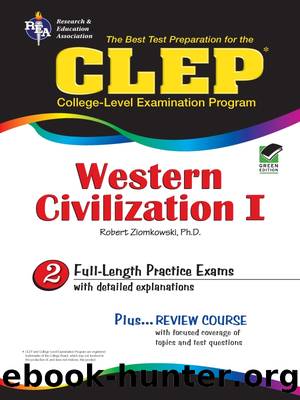CLEP Western Civilization I - Ancient Near East to 1648 by Robert Ziomkowski

Author:Robert Ziomkowski
Language: eng
Format: epub
Publisher: Research & Education Association
Published: 2011-12-12T00:00:00+00:00
CHAPTER 6
Early Modern Europe
THE AGE OF EXPLORATION
During the Renaissance and Reformation, Europeans were embarking upon naval expeditions that looked beyond the confines of their world. The leaders in these voyages of discovery were the Portuguese and Spanish, who sometimes hired Italian captains.
Prince Henry the Navigator. A Portuguese prince known as Henry the Navigator (1394â1460) gave the first major impetus to exploration by funding voyages of discovery and establishing a school for navigation at Sagres, which included an observatory. He also made improvements in shipbuilding, and the caravel was adopted as the favored vessel for exploration. Henryâs motives reflected military, religious, and economic concerns. His patronage of exploration began after he participated in the 1415 capture of Ceuta, a Muslim stronghold in North Africa across from the Strait of Gibraltar. He hoped that a more precise knowledge of African geography would help Christian forces to outflank the Muslims and thus gain a strategic advantage over them. He also hoped to make contact with a legendary figure named Prester John, who was rumored to rule a Christian kingdom in distant lands (possibly Ethiopia). More realistically, Henry thought to discover and convert pagans who lived on the edge of Muslim territories, thereby combining religious with military motives. Finally, Henry hoped to find deposits of gold and to generate wealth for Portugal by establishing a trade route to the Indies that could bypass the Mediterranean, which was dominated by the Italians and Turks.
Portuguese Exploration. With the support of Prince Henry, Portuguese explorers discovered the Azores, Canary, and Cape Verde Islands in the Atlantic Ocean and followed the African coast as far as Sierra Leone near the equator. They established a lucrative trade in gold, ivory, and slaves. In 1488 Bartholomew Diaz crossed the equator, sailed to the southern tip of Africa, and rounded the Cape of Good Hope. In 1497â1499 Vasco da Gama sailed to India and back, opening a trade route for spices and other luxury goods. In 1509â1515 Alfonso de Albuquerque established Portuguse trading posts along the west coast of India, the islands of Indonesia, and at the mouth of the Persian Gulf, thereby laying the foundations of the Portuguese Empire in the east, which was linked back to the capital of Lisbon through trading posts that dotted the African coast. In 1500, Pedro Cabral claimed Brazilâthe only Portuguese territory in the New World.
Early Spanish Exploration. After the early successes of Portugal, the Spanish realized the potential for wealth that exploration could generate and became anxious to prevent their Iberian rival from dominating this trade. In 1492, Ferdinand and Isabella decided to fund a voyage by the Genoese mariner Christopher Columbus (1451â1504), who claimed that he could find a direct western route to the Far East without having to sail around Africa. Columbus had miscalculated the circumference of the earth and had no idea that massive continents barred the way, so that when he discovered the Caribbean islands (West Indies) and Central America, he thought he had reached Asia. Columbus established contact with the natives in four voyages, the last ending in 1504.
Download
This site does not store any files on its server. We only index and link to content provided by other sites. Please contact the content providers to delete copyright contents if any and email us, we'll remove relevant links or contents immediately.
Real Estate License Exams For Dummies by Yoegel John A(878)
The Strategy Paradox by Michael E. Raynor(802)
Series 7 Exam For Dummies by Steven M. Rice(718)
The Back of the Napkin by Dan Roam(712)
The Waste Land and Other Poems by T. S. Eliot(704)
The Lewis Man by Peter May(672)
Cracking the CSET (California Subject Examinations for Teachers) by Princeton Review(662)
Series 7 Exam for Dummies, with Online Practice Tests by Steven M. Rice(645)
Ultimate Aptitude Tests by Jim Barrett(626)
Securities Industry Essentials Exam For Dummies with Online Practice by Steven M. Rice(621)
Series 7 Exam For Dummies by Rice Steven M(619)
Lewis 02: The Lewis Man by Peter May(604)
Ultimate IQ Tests: 1000 Practice Test Questions to Boost Your Brainpower (Ultimate Series) by Russell Ken & Carter Philip(602)
Post Office Jobs by Dennis Damp(566)
The Official DVSA Guide to Driving the essential skills by Driver & Vehicle Standards Agency(555)
A Bend in the Road by Nicholas Sparks(542)
Test Your Emotional Intelligence by Philip Carter(534)
ARRL's General Q&A by ARRL(511)
Schaum's Outline of College Algebra by Murray Spiegel(499)
